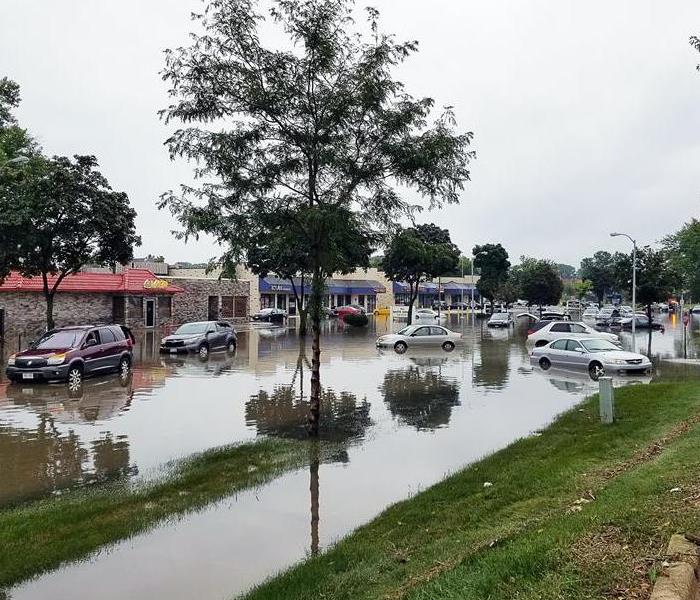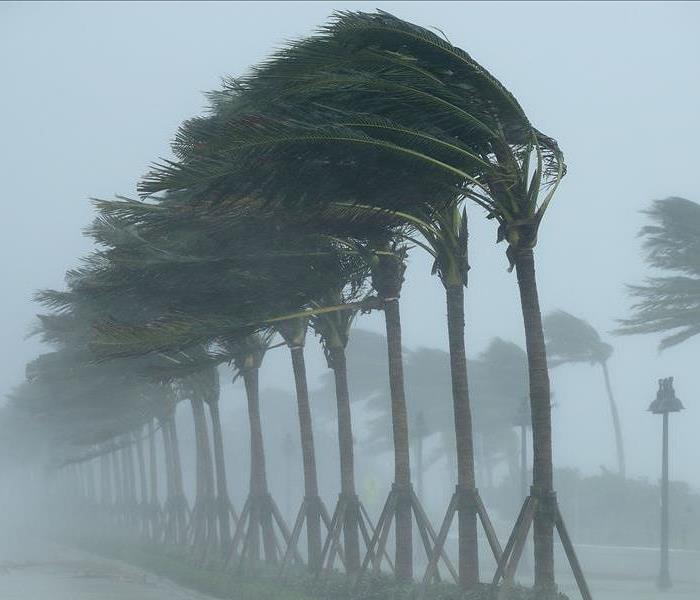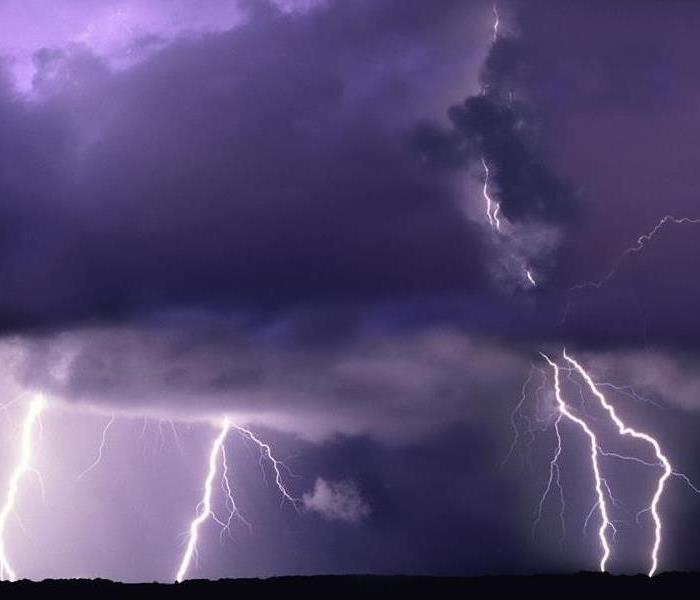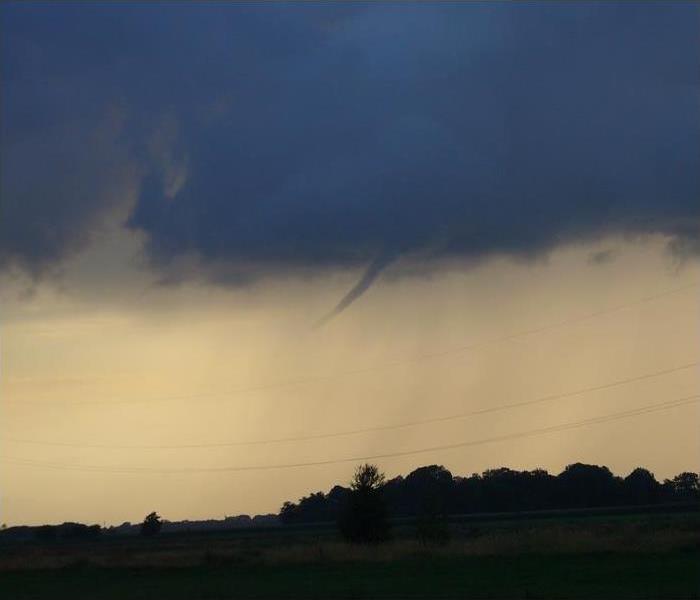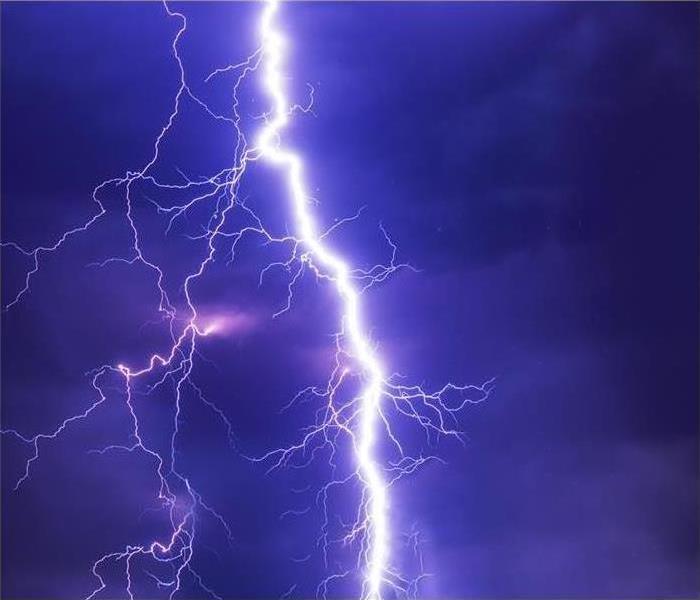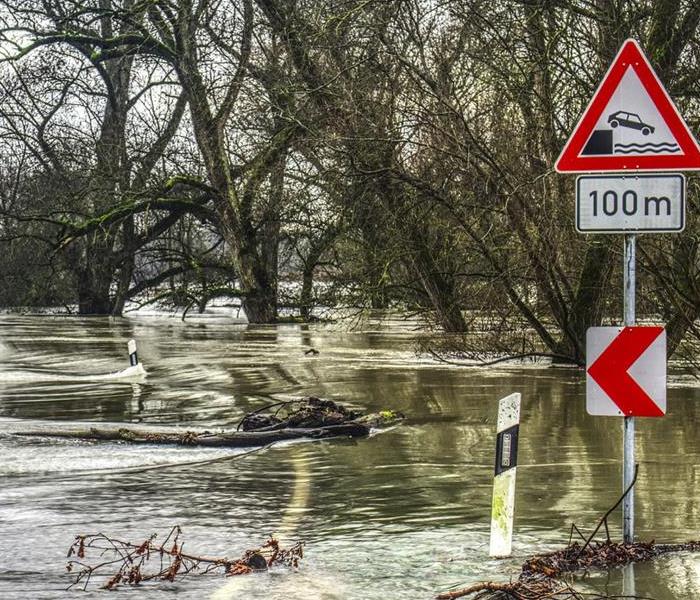Recent Storm Damage Posts
How You Should Prepare Your Business For Storm Season
2/17/2023 (Permalink)
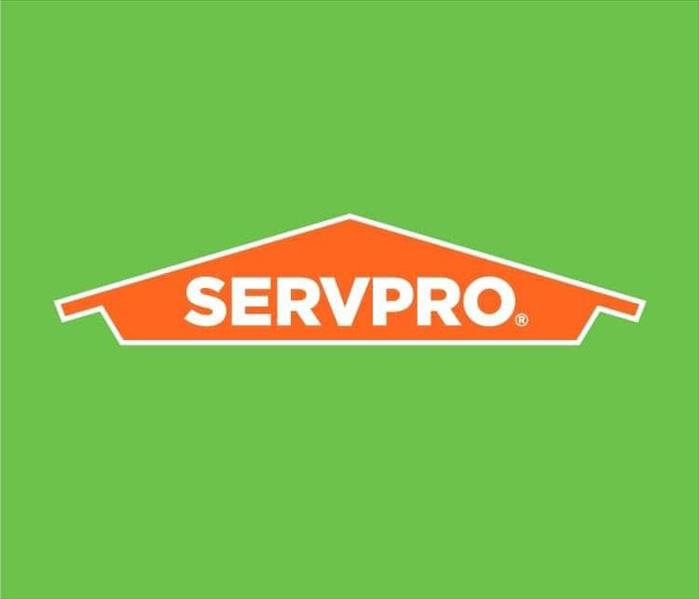 It’s never too early to start preparing your business for the next big storm season.
It’s never too early to start preparing your business for the next big storm season.
As hurricane season begins, businesses should consider preparing for the upcoming storm season. In fact, there's no better time to think about this than now. Hurricanes can be devastating to your business if you don't plan accordingly.
With little planning and preparation, you may save your company time and money by taking basic safeguards that won't break the bank or require too much time. This article will walk you through the steps of preparing your business for the storm season.
#1 Create a comprehensive plan
Natural catastrophes, according to FEMA and the US Department of Labor, can permanently and promptly close 40 percent of small enterprises. 75 percent of organizations that do not have a business continuity strategy in place will collapse within the next three years.
Businesses should prepare for all circumstances, including storms, by developing a business continuity strategy. Because certain calamities are more difficult to foresee in advance, you'll need a specialized Emergency Plan to protect your most vital assets and communications. Check for state and local government plans as well, since their guidelines will take regional characteristics into consideration.
#2 Form an Emergency Response Team
Before a storm arrives, you must have a strategy, which includes knowing every aspect of your organization that might be impacted. That's definitely too much for one individual to do, as no single employee can keep track of every member of your team's daily activities.
However, if you want to create a thorough emergency plan, you'll need to form a cross-sectional Emergency Planning Team that includes representatives from all areas of your company. You'll also want to vary the degree of seniority and sort of personnel you hire, because someone who works shifts, for example, will have a totally different viewpoint than a full-time nine-to-fiver.
#3 Prepare for the worst-case situation
When a storm is on its approach, you don't want to be hurrying to prepare, only to realize you haven't done enough—
- You may choose to work with your IT team to find the best solution for the way your company does business
- Cloud software that continuously updates off-site servers, External hard drives for electronic vaulting
- Prepare your office and building by relocating sensitive equipment away from windows and the lowest levels
- Consult with an engineer to assess the structural strength of walls, awnings, and other parts of the building
- Consider investing in an Uninterruptible Power Supply
#4 Considering Physical Security
You must comprehend the physical preparations your firm must make to be ready for a hurricane or tropical storm, in addition to a flood or evacuation chart. Is your structure prone to floods in certain areas? Do you need to board up a lot of windows? Is there anything that needs to be carried in, locked, or secured?
These factors are equally vital to consider when preparing your building for the impending storm. If your area is particularly vulnerable to floods, have someone switch off the breakers and move any critical equipment out of the water's reach. If your servers are in the basement, you'll need to find out how to relocate them.
#5 Examine your insurance
The most crucial item to look for in an insurance policy is your deductible, which will tell you how much money you'll be responsible for before you can begin rebuilding. You should also check your exclusions to ensure that you are covered for floods, windstorm damage, fees associated with setting up a temporary site, and any personal property you may have on the premises.
#6 After the hurricane, hire a disaster recovery service
Hurricanes, tropical storms, and the flooding that accompanies them may wreak far more damage than first appears. Even if your company appears to be in good shape, hiring an expert to do storm damage restoration and analyze the damage is the best course of action. Electrical and utility damage can generate a wide range of issues that you may not have anticipated, posing safety risks or causing much more harm in the long run.
Storm damage restoration services are quite important once a storm has affected the region. You may call them immediately following the occurrence of a disaster, therefore keep the contact information of the agency ahead of time so you may contact them when you need them.
#7 Restore Your Data and Repair Your Equipment
Depending on your sector, it may be necessary to consult with specialists about fixing any critical equipment that must remain on-site. Again, even if something appears to be unaffected, you won't always know what's going on under the hood.
Contact an expert such as storm damage cleanup services and let them determine what is safe to use and when you may use it. Send hard drives to expert data recovery agencies to see what they can retrieve for computer equipment.
#8 Recover and reopen: business as usual
As you clean up with the help of professionals from storm damage cleanup services, consider ecological alternatives for your garbage. Many things may be recycled, but you must ensure that electronics and other sensitive materials are disposed of safely. Remember that moisture is your enemy, and utilizing an air conditioner or a dehumidifier may help you dry things out as fast as possible.
Conclusion
With the potential for a major storm hitting your area in the year 2022, it’s important to be prepared. It’s never too early to start preparing your business for the next big storm season. With a little preparation, you can help ensure that your business will weather any storm and come out with minimal damage and downtime. If you want assistance during the rehabilitation process, our team of specialists is available 24/7!
Dealing with Power Outages After a Storm
2/17/2023 (Permalink)
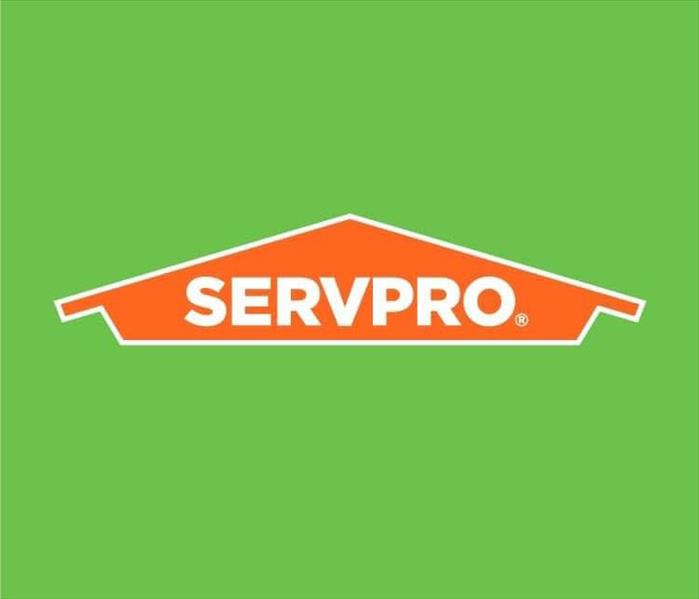 By following the tips in this article, you can make sure that you stay as safe and comfortable as possible until power is restored.
By following the tips in this article, you can make sure that you stay as safe and comfortable as possible until power is restored.
One of the most common things you will have to deal with after a storm in Florida is power outages. It can get annoying as there are things that can only be done with electricity—like cooking or charging your phone—and so when the power goes out, it’s important to keep these things in mind. That way, if the power doesn’t come back on right away, at least you won’t end up completely lost without any way of communicating with anyone else who might be nearby. But what should you do first? Read on!
Contact storm damage cleanup services.
Before anything can get fixed in your area, all the wind damage from the storm needs to be cleaned up first. This includes not only repairing any broken power lines or trees but also making sure that all the debris from the storm is cleared away. Depending on how bad the storm was, this could take a while, so it’s best to get started as soon as possible.
More importantly, contacting storm damage cleanup services will shed light on the cause of your power outage. Sometimes, a storm can be so severe that it knocks out more than just one thing at once—and if this is happening, then getting help from storm damage restoration professionals will ensure all problems are resolved quickly and efficiently without leaving any lingering issues behind them. Storm damage restoration professionals can check which parts of the house have been damaged by fallen trees and fix them, if need be, as well as replace broken windows or trim back branches on your home’s roofline.
Contact your utility provider.
As soon as everything is cleaned up, you should contact your utility provider. If there’s been a major storm in the area, then they may already know about it—but it can’t hurt just to confirm that everything is alright on their end and find out when power might be restored for you personally. You may also want to ask how long this outage will last, as it’s possible that your area has been hit harder than others. Not contacting them immediately will only lead to further delays, so it’s best to get on the phone as soon as possible.
Conserve energy.
While waiting for the power to come back on, you should conserve energy as much as possible. This means turning off all lights and appliances that aren’t being used, unplugging anything from an outlet (even if it isn’t in use), keeping windows closed during cold weather months when heat might be needed indoors, and of course, not running the dishwasher or washing machine.
Conclusion
Power outages are expected after a major storm, but that doesn’t mean they’re any less annoying. By following the tips in this article, you can make sure that you stay as safe and comfortable as possible until power is restored. And if it looks like things are going to be taking a little longer than expected, at least now you know what to do.
What Happens During a Water Damage Removal Process?
2/17/2023 (Permalink)
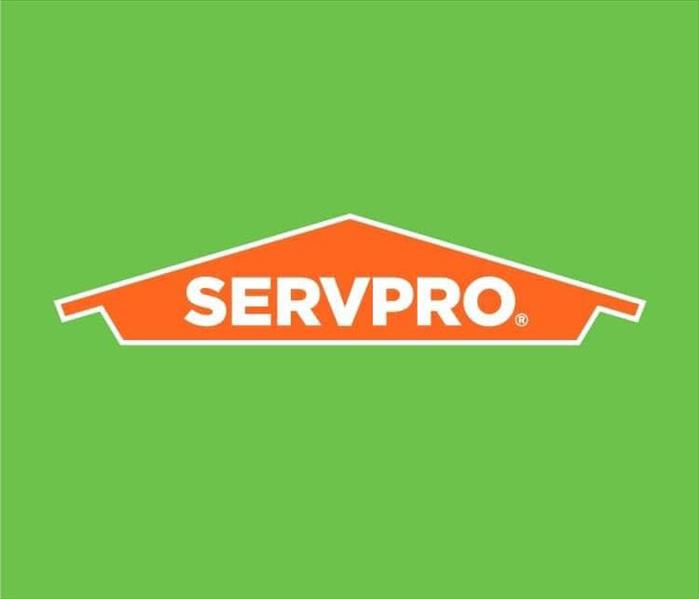 The sooner you start the water damage removal process, the less damage your property will sustain.
The sooner you start the water damage removal process, the less damage your property will sustain.
Water damage can be a serious issue. If your property got damaged from a storm and it has not been addressed quickly, water damage can cause mold growth, structural damage, and even electrical problems. And when your house is hit by a storm extensively, it could have a huge impact on the structural integrity of your home.
In this article, we will discuss what happens during a water damage removal process. By understanding what takes place during a water damage removal process, you can be better prepared in the event of an emergency.
Inspection and Assessment
The first step to any storm damage restoration process is to inspect the property and assess the damage. This is to determine what needs to be done to safely and effectively remove the water and repair the damage. When you contact storm damage cleanup services, they will send a team of professionals to your property to assess the damage and create a plan of action.
It's important to have a storm damage restoration action plan that is tailored to your specific situation because every water damage removal process is different. The plan will be based on the severity of the damage, the type of water that caused the damage, and the size of the affected area.
Water Extraction
Once the inspection and assessment are complete, it's time to start extracting the water. This is usually done with industrial-grade pumps and vacuums. The amount of time it takes to remove all the water will depend on the extent of the damage. In some cases, all the water can be removed in a matter of hours. In other cases, it could also take a couple of days and even weeks!
Drying and Dehumidification
Once all the water has been extracted, the next step is to dry and dehumidify the property. This is done to prevent further damage and mold growth. If any moisture is not removed, it can lead to serious problems down the road. This is why it is important to hire professionals since they know exactly where to look for moisture and how to remove it.
Cleaning and Sanitizing
Once the property is dry, it's time to start cleaning and sanitizing. This is an important step in the water damage removal process because it will help to remove any harmful contaminants. Professionals will use special cleaners and sanitizers to clean the affected areas.
Restoration
The final step in the water damage removal process is restoration. This is where the damaged areas are repaired and restored to their original condition. In some cases, this may mean simply repairing drywall or replacing carpet. In other cases, it may mean rebuilding an entire section of the property.
Conclusion
No matter how serious the water damage is, it's important to have it addressed as quickly as possible. The sooner you start the water damage removal process, the less damage your property will sustain. If you're ever in need of storm damage cleanup services, be sure to contact a reputable company that can help you through the entire process.
Storm Shutters: A Good Investment and its Benefits
8/15/2022 (Permalink)
 Storm shutters can be a great help to lessen the effect of storms.
Storm shutters can be a great help to lessen the effect of storms.
It is crucial to take the necessary preparations if you reside in a region that is vulnerable to hurricanes, tornadoes, or other severe storms. Storm shutters add an additional layer of defense against wind and water harm. Do you need to buy storm shutters or just contact a storm restoration company to conduct a storm damage cleanup?
USES OF STORM SHUTTERS
To put it simply, window shutters shield your house from extra wind and water damage during storms. This can’t be eliminated and you might need help from a storm restoration company, but shutters can lessen the chance of glass windows breaking and flying into your house during strong winds.
What precisely are the various storm shutter types? You have a variety of storm shutter options, depending on where you reside and how your home was built. Wood, fiberglass, metal, and even a robust and water-resistant cloth are all options for hurricane shutters. Some shutters roll down and lock like cabinet doors, while others close and tighten like an accordion.
ADVANTAGES OF BUYING STORM SHUTTERS
So, the big question is: Should you spend money on storm shutters?
Shutters are a great purchase, especially if you live near the seaside, for the following reasons.
- The risk of damage from flying glass or other debris is reduced by shutters.
- They lessen the overall damage that any kind of storm causes.
- In order to protect your home from potential floods, hurricane shutters are an additional measure.
- They raise your home's total resale value.
- They reduce the cost of repairs, particularly if your home's insurance does not cover damage from hurricanes.
Investing in hurricane shutters only makes sense if you choose a reputable brand that offers protection.
Although the initial cost may seem high, keep in mind that you will probably save money on home maintenance. You might always opt to seek assistance from a storm damage cleanup company.
Finally, compare the cost of storm shutters to your homeowners insurance. After that, decide based on your own requirements.
ADDITIONAL MEANS OF PREVENTING STORM DAMAGE TO YOUR HOME
There are other ways besides storm shutters to keep your house from being destroyed by a storm. If you are aware that a storm is approaching, you should take the following safety measures.
- For insurance purposes, take photos of your house before and after the storm.
- Place priceless goods in a waterproof safe.
- Use tarps to shield electronics and furnishings.
- Secure outdoor furniture with bolts to prevent wind from blowing it into your home.
- Electronics should be unplugged to avoid power outages.
- Sealing door frames will help reduce flooding.
In conclusion
Storm shutters can be a great help to lessen the effect of storms but emergency responders strongly advise against keeping your storm shutters closed throughout the entire year.
Only when a storm is imminent should they close. In the event of an emergency, exercise caution. Your decision to keep your hurricane shutters closed has a negative impact on emergency efforts and operations.
The Storm is Over: Here's How to Jumpstart Your Commercial Restoration
8/15/2022 (Permalink)
 You can rely on SERVPRO to take care of everything while you focus on what matters most.
You can rely on SERVPRO to take care of everything while you focus on what matters most.
It also helps to consider what you can do next to get your commercial property back in order once you've taken all the required precautions and the storm has passed.
Anyone who experiences major storm damage may feel overwhelmed and as though their world has been flipped upside down. And it's acceptable to feel this way given that you have to work on resuming your life and kick-starting your property rehabilitation and have a commercial storm damage cleanup.
Knowing what to do after a storm has hit your commercial place is helpful since it can help you organize your storm cleanup. You can prevent further damage to your family, possessions, and hard-earned money by using this knowledge and having a strategy in place. In the end, it can assist you in getting your life and possessions back as quickly as feasible.
To that end, here are four suggestions that should make managing storm damage cleanup and restoration at least a little bit easier for you:
#1 Always prioritize your safety
No matter how many hurricanes, floods, or thunderstorms you've survived, it's always important to prioritize your safety.
If you had to leave your commercial place prior to the storm, it could be wiser to remain at an emergency shelter, a hotel, or with friends or family. A simple approach to keep yourself and your loved ones safe is to have your examined for risks before you return.
Even if you didn't have to leave, you should check to make sure it's safe to go outside again before you begin looking for damage. There may also be adjacent risks including slick spots, broken glass, exposed electrical wires, and damaged gas lines.
#2 Document storm damage
The following are some typical storm damages to watch out for:
- Leaky roofs, missing or broken shingles, split seams, and dents in the gutters
- Exterior sliding that is harmed or missing
- Window cracks, shattered glass and frames, and smashed doors
- Outdoor equipment that is faulty or damaged, such as air conditioners
- Flooding in the cellar
- Electrical shorts that cause fires or water getting into outlets
If you have any of these on your property, make sure to take pictures of everything before moving or removing them. To assist your insurance carrier in determining the extent of the loss, all damages must be properly documented. It can also speed up the process to take pictures from various perspectives and include images of your property before it was damaged, which brings us to our next point.
#3 Call you Insurance Company
Once your photos are prepared, you can contact your insurance company to begin the commercial storm damage cleanup and restoration process by reaching out to SERVPRO near me.
A representative will respond to your questions, outline the coverage provided by your policy, and dispatch a claims adjuster to assess the property damage.
Once you've gotten in touch with your provider, continuing to communicate with them until your claim is settled might give you one less thing to stress about while working on your restoration.
#4 Contact a Professional Storm Cleanup and Restoration Teams
To prevent further issues, you can take care of the smaller fixes, but it's important to bear in mind that specialists should still be called in to handle storm damage cleanup and restoration.
Looking up, SERVPRO near me will help if you're looking for a nearby team who provides storm cleanup and restoration 24/7.
You can rely on SERVPRO to take care of everything while you focus on what matters most during this difficult time thanks to our commitment to professional restoration solutions and client satisfaction. Call us right away if you need assistance.
Should Storm Damaged Floors Be Replaced or Repaired?
3/22/2022 (Permalink)
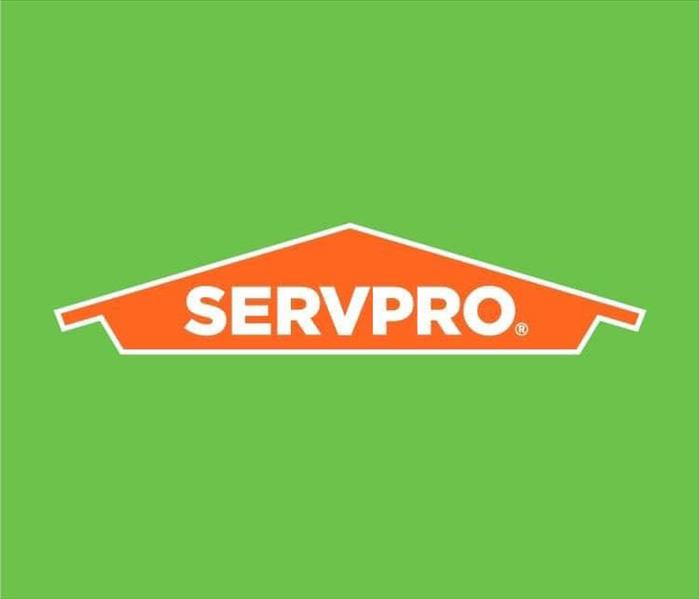 The best way to decide whether you should get your floor repaired or replaced is to get the advice of storm damage restoration professionals.
The best way to decide whether you should get your floor repaired or replaced is to get the advice of storm damage restoration professionals.
A storm wreaks havoc on your home and leaves behind damage to the surface of your floors. Should you repair the damage or replace the damaged areas? It’s sometimes difficult to decide whether you should spend money on replacing a damaged floor.
If you live in an area that is more likely to experience water damage caused by storms, time is essential. Prolonged water damage can lead to pest infestations, mold growth, and even damage to your property’s foundation. If you are thinking about repairing or replacing the damaged floor, here is what you need to know.
Check out the severity of the damage.
Before doing any storm damage restoration, the first thing you should do is determine the severity of the damage. Contact a storm damage repair contractor Volusia who can do a proper assessment of the damage. They will check out different factors like water damage and mold damage and give you an estimate of the cost. This way you will know how much money to spend on the repair work.
What types of repairs can be done?
It’s possible to repair damaged floors without having to replace the entire surface. In most cases, you can return your floor to its original state. For example, if it’s just a small crack, you may be able to do this by yourself. You just need quality tools and materials for it. However, if the storm damage is more severe, you should always call a professional. They have the expertise and the tools to properly repair a storm-damaged floor. They know how to perform what sort of repairs are needed for your floor to return to its original state.
Do you need to replace the entire floor?
If your entire floor is damaged, replacing it is the most cost-effective option. Replacing the floor will eliminate the need to find materials that would match the entire look of the room. If the damage is only in one area, such as a kitchen or bathroom, then repairing that area is still advisable. In many cases, replacing the entire floor is a better option.
Is it worth it to repair the damaged floor?
This decision will depend entirely on the cost, time, and labor involved. Repairs can only be done up to a certain point. Is the wood too damaged to repair? Is it going to take a long time for the repairs to be made? Is there a possibility that the floor will get damaged again? If you answered yes to any of those questions, repairing won't be worth the cost.
Conclusion
There is no one-size-fits-all answer to the question of whether you should repair or replace your damaged floor. The best way to decide is to get the advice of storm damage restoration professionals. They will have the knowledge and expertise needed to give you an accurate assessment of the damage and proper advice on how to proceed with your repairs. Contact a storm damage repair contractor Volusia for a proper inspection and estimate.
How to Properly Document Property Damage After a Storm
3/22/2022 (Permalink)
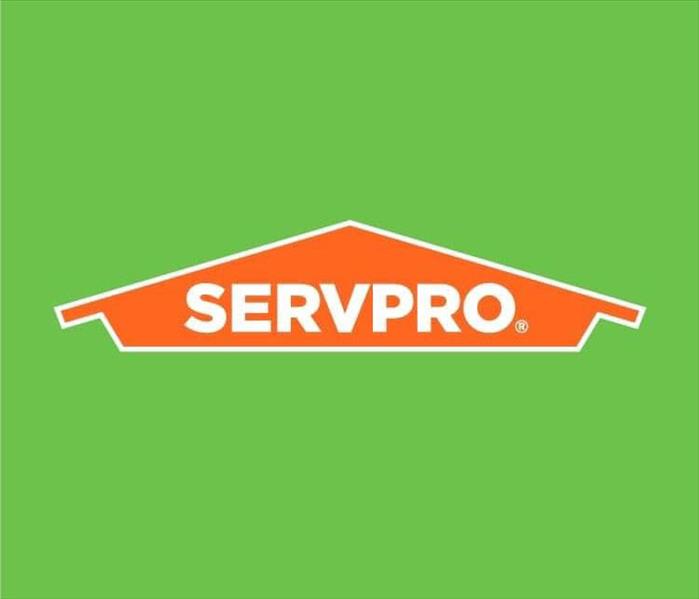 Documenting the damage in your property after the storm is important to speed up the storm damage restoration and insurance claim process.
Documenting the damage in your property after the storm is important to speed up the storm damage restoration and insurance claim process.
It's been a few weeks since the storm hit, and you've finally had some time to assess the damage. Your home is in shambles, trees are down all over your property, and there's water damage everywhere. You know you need to start the insurance claim process, but where do you begin?
Follow these steps to make the storm damage cleanup process as smooth as possible.
Hire storm damage cleanup services.
The most important step you can take after a storm is to hire professional storm damage cleanup services. A reputable company will have the experience and equipment necessary to assess and then clean up your property safely and effectively. They will also be able to provide you with a detailed report of the damage, which will be essential for your insurance claim.
Storm damage restoration can be a lot more complicated than you think. It's important to let professionals do their job so that you can avoid any further damage.
Take photos and videos.
You can work with the cleaning company and document the damage by taking photos and videos of every damage and loss. This will help you provide a visual representation to your insurance company. Make sure to photograph both the exterior and interior of your home and document any damage to personal property. That way, you can be sure that you won't miss anything when filing your claim. More importantly, take photos and videos before the storm as well.
Photos and videos can also be used as evidence if you need to go to court.
Create a list of all damaged items.
Next, create a list of all the damaged items. Having a list of all damaged items can help you organize things later. You can also easily track what things you need after the storm if you have a list of all damaged items. This can include anything from furniture and appliances to clothes and jewelry. If you have receipts for any of these items, be sure to include them in your claim. Again, this will help ensure that you don't miss anything when filing your claim.
Keep track of all expenses related to the storm damage.
If you must make any repairs or purchases related to the storm damage, be sure to keep all receipts. This way, you will get reimbursed by your insurance company for these. Moreover, it's also important to keep track of expenses like missed workdays or hotel stays. This can also include canceled checks, bank statements, and more. By documenting all your expenses, you can be sure that you won't be left out of pocket after the storm.
Conclusion
Filing an insurance claim after a storm can be overwhelming. But by following these simple steps, you can make the process as smooth as possible. Remember to stay patient and be persistent. The insurance company will want to see all your documentation before deciding on your claim.
If you need help getting started, contact a storm damage restoration company. They will be able to guide you through the entire process and help make sure that you get the reimbursement you deserve.
Basement Floods After a Storm: What to Do?
10/20/2021 (Permalink)
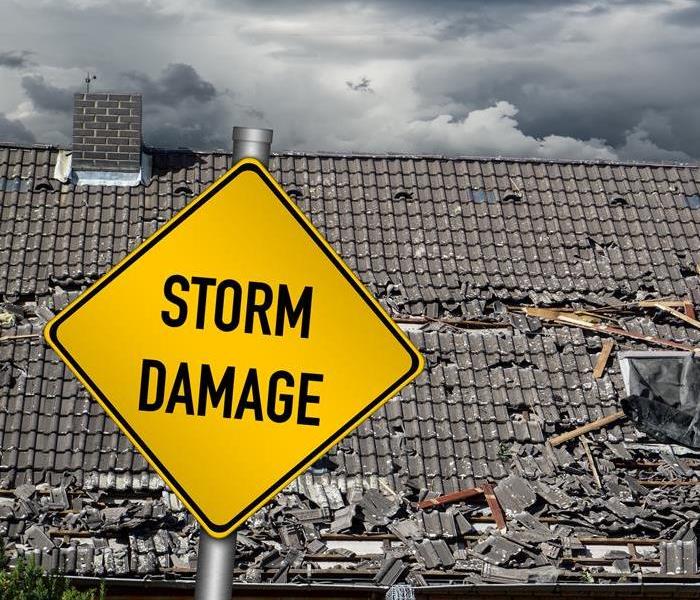 A roof with storm damage.
A roof with storm damage.
Basements are one of the most vulnerable parts of a home to flooding, and after heavy rain or snowstorm, many homeowners find themselves dealing with water-soaked ceilings and walls. As you begin to clean up and dry out your basement, there are several important things that you need to do to prevent future problems.
Shut off running pipes.
If the source of the flooding is a pipe, you'll want to turn it off as soon as possible. You can do this by shutting off just the pipe that leads to the basement. In any case, you can temporarily turn off all pipes until you figure out what's causing the basement to flood.
Remove all wet items from the basement as quickly as possible.
You'll want to move quickly and take out all of the wet items from your basement as soon as possible. Keep in mind that if you don't clean these items immediately, they will mold which can lead to further damage. Be cautious when removing wet insulation or carpeting because it may hold moisture for several days after exposure to water.
While you may think that a flooded basement can be easily cleaned up, it's important to remember that mold and mildew can grow very quickly under the right conditions. If not taken care of immediately, this problem will only get worse as time goes on and it can affect the health of your entire home.
Inspect for any cracks or weak spots in your basement walls.
If you find any cracks or weak spots, you'll want to repair them as soon as possible. If the source of water is coming from outside your home, then this may mean calling a contractor for help.
Call a Storm Damage Restoration professional.
Storm damage cleanup can be a complicated and confusing job, so you may want to call a storm damage restoration professional. These technicians can help with everything from removing water-damaged materials to restoring the air quality of your home after flooding. They will also help you with repairs and waterproofing to prevent future flooding in your basement.
Contact your insurance company about what coverage is available to protect against future floods.
Flooding is a common occurrence in the U.S. In fact, 90% of all natural disasters in the U.S. involve flooding. This is why you must have coverage in any case. If you have flood insurance coverage, contact your insurance company about what protection is available to help with cleanup and reconstruction of any damaged property. They may even be able to help you with the cost of your next home improvement project.
Conclusion
Right after a storm, many homeowners are surprised by how expensive it can be to deal with flooding in their basement due to extensive damage and necessary repairs. A storm damage cleanup professional can help you with the entire process of restoring your home after a flood. With some quick steps and by taking care of the damaged property as soon as possible, you'll get through this difficult time with minimal effort.
Strategies to Prepare Your Business for Storm Season 2021
9/8/2021 (Permalink)
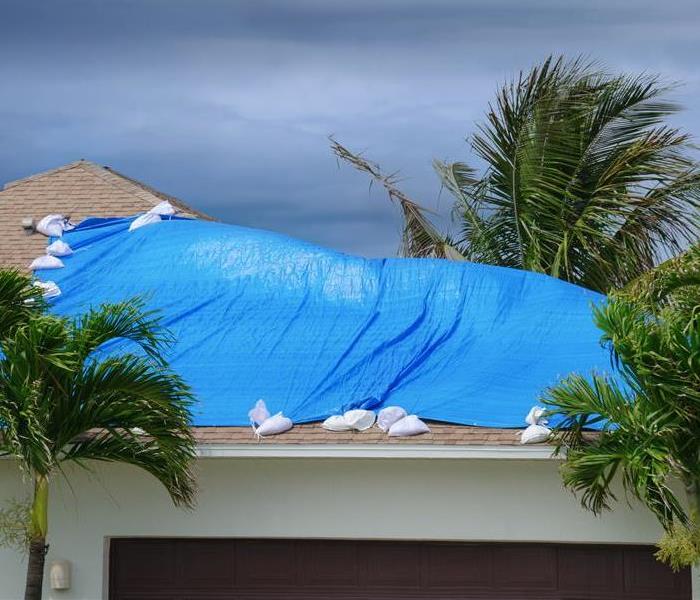 Storm Damaged Roof
Storm Damaged Roof
Many of us are now preparing our homes and businesses for what could potentially be some of the worst storms we've seen in years. There are plenty of things you can do now or before the storm season starts to prepare your business for any potential disasters.
Create an emergency plan.
This emergency plan should be created with your employees in mind and should include what the building’s evacuation procedures are, how customers will be notified if a storm is approaching, where you can go to stay safe during storms or disasters, and much more. Be sure that everyone on staff knows about this storm damage restoration plan so they can reference it when disaster strikes.
Create a list of emergency numbers to keep on hand at your business, in case you need to call someone for help once the storm hits. The employees who will be working during storms or disasters should also have this information readily available so they can contact loved ones and check in with them if communication is limited after a disaster.
Set up an emergency response team.
It's important to know who you should call first in the case of a disaster or an emergency at your business. You'll want to have several key people on this team, such as local authorities (police and fire departments), rescue workers, storm damage cleanup services, insurance providers, etc. The aftermath of a storm can be chaotic so it’s important to have a proper plan and contact information for storm damage restoration.
Take inventory of what's inside your facility.
It's important to know what kind of equipment, facilities, or supplies you have inside your building. You'll want to take inventory of every piece of technology and valuable item so that if something is damaged by a storm, it can be replaced quickly without much hassle. More importantly, it will be sorted easily with storm damage cleanup services.
Stock up on emergency supplies and prepare your facility.
Include things like food, water (for both employees and any pets that are in your care), first aid kits, flashlights, batteries for radios, or other pieces of technology you may use during a storm season. Clean up the exterior of your building to limit potential damage from storms and falling objects.
Stay informed of forecasts from your local weather station.
This is one of the most important things you can do to stay safe during a storm season or a disaster. Make sure that all employees are aware of what's going on in their area and have watches, warnings, etc., readily available if necessary so they know when it might be time for an evacuation order or other emergencies.
Conclusion
As we've seen in the past couple of years, storms and disasters can hit at any time. The best thing you can do to prepare your business for storm season is come up with an emergency plan of time and have it readily available and accessible for employees, so they know what needs to be done if disaster strikes.
3 Ways to Mitigate Wind Damage
7/2/2021 (Permalink)
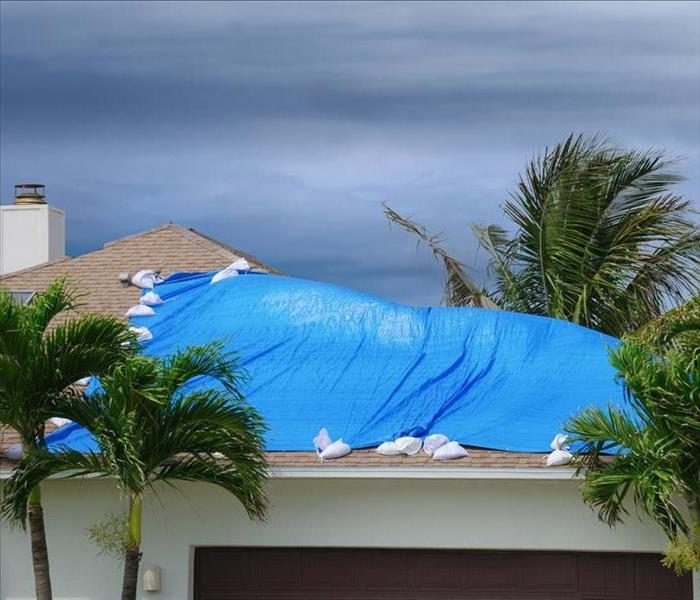 Wind can cause serious damage to your home.
Wind can cause serious damage to your home.
Three Ways To Limit Wind Damage
Damage caused by wind can occur alongside storm damage or separately due to strong gusts. In the worst-case scenario, wind damage to the roof, windows or any other part of a commercial structure could result in a roof leak or expose the interior. Here are three ways to limit wind damage to the exterior and interior of a commercial building.
1. Inspect a Structure for Wind Damage
After a windstorm subsides, the owner or manager of a commercial building can identify several signs of damage. Missing shingles may be evident on a pitched roof or on the ground. It may also be helpful to go up on the roof or arrange for a professional roof inspection after windy weather.
2. Board Up or Tarp Over Breaches
Any breaches in a structure should be covered. While missing roofing materials may lead to a roof leak, a broken window or damaged door can leave a building open to the intrusion of flying debris, rain or trespassers. Board up accessible openings in a building or use tarps and anchor boards to prevent rain from penetrating into damaged roofing until repairs take place.
3. Restore Damage As Soon As Possible
It is a good idea to repair a damaged roof or other types of damage caused by wind sooner rather than later. Even if high winds are expected to continue, a well-maintained or recently repaired structure may be less susceptible to repeated damage, whereas a structure that has already sustained damage may suffer more severe storm damage.
High winds can cause a roof leak and damage the enclosure of a commercial building. If loose flashing or the failure of a window or door compromises any part of a structure, storm damage restoration will be necessary to address external problems that expose a building interior to storm damage.
Tornado Safety Plan, What You Need To know
1/4/2021 (Permalink)
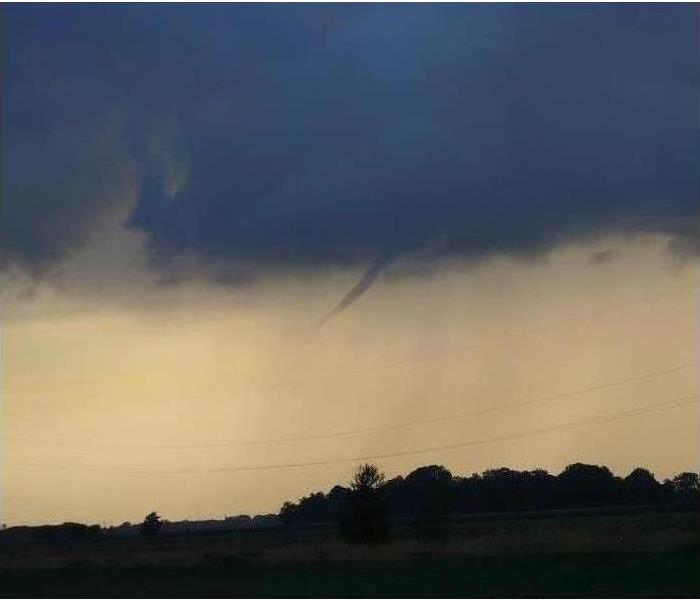 Do you have a Tornado Safety Plan?
Do you have a Tornado Safety Plan?
We do not see them very often in Central Florida. However, during some major storms, the threat of a tornado can become very real, very quickly.
SERVPRO of West Volusia County specializes in flooding and storm damage restoration, but our first priority is you. That's why we wanted to share a few safety tips with you so that in the event of a tornado, you know what to do.
- It is important to know the difference between Tornado Watches and Tornado Warnings. If a Tornado Watch is issued for your area, it means that weather conditions are favorable for a tornado to occur. If a Tornado Warning is issued in your area, it means a tornado has been detected in your area and you should seek shelter immediately.
- If a tornado warning is issued in your area, make sure that everyone in the home goes to an interior room on the lowest floor with no windows. Usually, this would be a basement, closet or bathroom.
- It is always a good idea to have a portable battery-operated radio. That way in the event of a tornado you are able to still listen to weather warnings and updates from your safe room.
In the event that damage occurs to your home or place of business due to a major storm...SERVPRO of West Volusia County is here for you. Give us a call at (386) 574-0864
How To Prevent Flooding In Your Central Florida Home
1/4/2021 (Permalink)
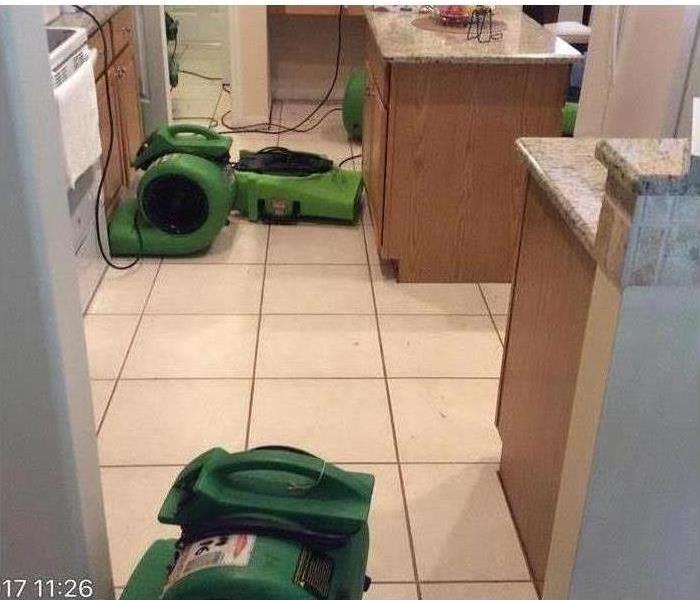 SERVPRO Is Here To Help!
SERVPRO Is Here To Help!
Flooding can happen anywhere and if you live in Florida, you know even one of our heavy afternoon thunderstorms can ensure flooding can happen "any time" as well.
It's a scary thought to think that your home could be underwater at a moment's notice.
So we thought we would share a few tips that can help you stay flood-free.
- Water flow - How does water flow around your house? It's important that it flows away from the structure. If it is noted that this is not the case, you may want to call an irrigation specialist to see if it is possible to correct it.
- Water valves - Two words: modify them. So many times in flooding cases we see sewage backup and overflow. That is the LAST thing you want to be dealing with, so it may be worth it to look at installing a back-flow valve.
- Lastly, in the event that you believe flooding is about to occur, move as many items as you can away from the rising water (electronics especially). Then give us a call, and we will be out there ASAP to help!
If you experience flooding or water damage, give us a call at (386) 574-0864.
Storm Damage Remediation In West Volusia County
9/16/2020 (Permalink)
Although There are Several Storm Damage Cleanup and Restoration Companies Out There, Only a Few Like SERVPRO Can Do The Job Right
Florida is infamous for its stormy, rainy weather. This weather and being surrounded by large bodies of water makes Florida especially prone to flooding.
So, area homeowners have to accept this ever-present risk. With that said, however, there are important ways you can limit storm flood damage and options for having it fixed. Prevention, of course, is always the best way to avoid related losses. Unfortunately, preventative measures may not always be possible. When this is the case, and flooding does impact your home, rest assured that services like SERVPRO of West Volusia can help you clean and restore your house.
Why are Services Like SERVPRO Better Than Others in Volusia County?
There are several critical benefits to enlisting the help of a skilled and highly experienced storm flood damage company like SERVPRO of West Volusia. Some of these benefits are:
- Our company's technicians, certified by the Institute of Inspection Cleaning and Restoration Certification (IICRC), completes the work correctly the first time.
- Our trained experts complete your job. We certify each of our professionals in health and safety, applied microbial remediation, applied structural drying, water damage restoration, and odor control.
- We have access to vehicles and equipment from the 1,700 other firms in our chain as a franchise in a nationwide chain.
- We can use a disaster recovery team to help resolve any major loss event you may experience.
- Our technicians have all the right tools to scientifically clean and restore your home. These tools include extractors, wet vacs, moisture meters/sensors, thermohygrometers, desiccant and refrigerant dehumidifiers, air movers, injectidry systems, powerful fungicides and disinfectants, and high-tech foggers.
With our professional workforce and equipment, we are often able to clean and restore your residence to pre-flood conditions in much less time than other service providers. Many times, this enables us to save you considerable time and money.
What are Some Preventative Measures I Can Take to Limit Potential Flood Damage?
Before severe storms, you should take some steps to limit potential flood damage. The following preventative actions, while not always entirely effective, do improve your odds of escaping the worst outcomes:
- Shutting-off your utilities before leaving your home
- Waterproofing your foundation
- Ensuring that your roof is in good condition and not leaking
- Making sure your gutters are clean and in good working order
- Using plywood to protect all windows and openings
- Diverting floodwaters with sandbags
These measures allow your house to weather Florida's severe storms and flooding for a while and work best against storms of shorter durations. Of course, the worst natural disasters usually overcome these defenses quite easily. In these cases, you certainly need the help of Seattle area cleaning and restoration professionals.
How Does SERVPRO Help Me with My Storm Damage Volusia County?
Once you call SERVPRO of West Volusia, there are several things we can do to help you. Our services generally include inspections, property securing, floodwater cleanup, hazardous waste disposal, microorganism elimination, home interior drying, and deodorization. When we arrive at your home, workers usually:
- Determine your residence’s level of water damage
- Extract standing floodwater from your home
- Remove fallen trees, other debris, and hazardous waste from your property
- Use EPA-approved disinfectants and fungicides to eliminate harmful microorganisms in your home
- Dry your home’s interior until it reaches a scientifically determined drying goal
- Deodorize everything, removing all unwanted flood-related odors
- Secure your home, if necessary, against the elements and would-be trespassers by placing roof tarps, installing fences, and boarding up windows and other openings
These actions effectively restore your home to pre-flood conditions and help prevent potential future issues.
Whenever you hear of a major storm’s approach, remember to prepare your home for possible flooding adequately. Simply waterproofing your foundation, ensuring your roof’s drainage system is functioning correctly, trimming dangerous overhanging tree limbs, boarding up windows and other openings, and sandbagging critical areas around your house can go a long way to protecting your housing investment. In many cases, all this should save your residence from the worst storm-connected damage.
There are times, of course, when whatever you do, you cannot save your property from significant injury. However, during those times, always remember that often even the worst flood damage can be remediated. When and if you do experience such weather-related losses, do your research and contact a good cleaning and restoration company to solve your problem. If you are ever unsure of anything and need help, you can always call SERVPRO of West Volusia County at (386) 574-0864.
Is Your Building Envelope Solid?
5/13/2020 (Permalink)
Water has a way of finding entry into a commercial building during storms and floods. Old roofs, cracked windows and faulty siding are just some of the ways moisture can infiltrate a property and cause rain damage. Too much moisture or high humidity in a building can cause structural weakness over time and promote the growth of mold. The presence of mold affects indoor air quality and can cause unpleasant odors in a building. There are many ways to address this issue by scheduling preventative maintenance, conducting regular inspections of the roofing system and fixing any leaks. Making sure your commercial building is sealed against moisture is a great way to protect your investment and its contents. SERVPRO of West Volusia is here to help.
The Damaging Effects of Water
Water is a corrosive element and can break down wood and fabrics and damage electronics. Its presence in the form of high humidity provides a fertile ground for black mold to proliferate. During a heavy downpour, it's important that your building has all of the elements in place to keep out moisture. A building envelope, which consists of your roofing system and grade wall systems, does the following:
- Protects against the intrusion of rain and hail.
- Funnels water away through the use of drains
- Provides weather protection and temperature control features
Rain damage poses a serious threat to the longevity of your building. In fact, floods are one of the most common disasters to impact a business. They can have devastating effects and can even cause a lengthy business disruption. Working with SERVPRO of West Volusia puts your company in a strong position to handle a disaster.
The best way to reduce rain damage to your building is to be prepared. Many buildings have cracks in the walls and other weaknesses that allow rain to get to areas where it doesn't belong. Shoring up these areas before a storm strikes is good business.
SERVPRO of West Volusia
386-574-0864
Storm Watch vs Storm Warning
5/13/2020 (Permalink)
Population size can affect the severity of a storm by at least 2% in rainfall. This is due to a higher temperature in cities like Deland, Debary and Deltona, Florida. Fortunately, our phones have the convenient ability to alert us of an oncoming storm, whether the storm happens tonight, tomorrow, or within the next few days. However, these alerts come with two different descriptions of the storm, a storm watch or a storm warning. Without being informed on the difference between the two, how can we know how prepared we need to be for storms headed our way? Here’s the difference. A storm warning is a less severe storm message.
A storm warning is for a storm that:
- will arrive soon
- lasts between twenty minutes and an hour
- covers only portions of a county
- indicates we should take cover when the message is received
A storm watch is for a storm that:
- will arrive within a few hours
- lasts for several hours
- can cover across multiple states
- indicates we should have a plan prepared for when it arrives
With this information, we can better prepare ourselves for when that message shows up on phones. The next time a storm message arrives, whether a watch or a warning, save your stress about the possibility of damage until the following day. And before looking for how to handle storm damage from last night, consider hiring storm damage specialists like your local SERVPRO, who have the power of a commercial company with the speed and customer service of a local company. SERVPRO of West Volusia can take all the hassle out of the inevitable. While we cannot avoid the path of a storm, they can restore our homes as though storms never happen.
SERVPRO of West Volusia
386-574-0864
Approaching Storm Season
5/9/2020 (Permalink)
Storm events are simply a part of our lives. Some are inconvenient; some are devastating. As a member of SERVPRO's Large Loss Team, SERVPRO of West Volusia is ready to respond.
When a storm event is coming, SERVPRO's Large Loss Team(s) coordinate staging equipment and employees ahead of the actual event. Hurricane's; tornadoes; flooding; fires;,etc., are all events where West Volusia has responded to. Large or small, SERVPRO of West Volusia is experienced and ready to mitigate the damage and work closely with you in restoring your property.
Residential or Commercial, we will be staffed and ready to respond. Call us today and let's discuss how we can work with you in being ready when disaster strikes.
SERVPRO of West Volusia
386-574-0864
Hurricane Season...It's Time to Start Preparing
5/9/2019 (Permalink)
Hurricane Preparedness Week (May 5-11, 2019)
There are so many essential tools and preparedness tips to get your family ready for hurricane season. Here in Central Florida, we know how important it is to make sure your family has a solid plan in place to stay as safe and secure as possible when facing a big storm. Here are a few guidelines we find most effective:
- Stay tuned to your local weather channels. Be in the know! It allows you the most time to prepare if a storm arises. It also allows for the most accurate local threats you may face during and after severe weather.
- Have an evacuation plan in place. Know where you would go, transportation avenues, and a timeline for travel.
- Finally, finalize an insurance plan that has the coverage you need to protect against severe weather damage. The majority of homeowners do not know the complete extent of what their insurance plan does or does not cover.
We hope these reminders assist you in planning for this upcoming hurricane season. Know that SERVPRO of West Volusia is always here for your storm restoration needs! (386) 574-0864.
Severe Weather Awareness Week - Florida
1/18/2019 (Permalink)
Florida Severe Weather Awareness Week is full of essential information and tips to help you be prepared in various severe weather events.
The awareness platform details ways to stay safe in the event of a lightning storm. (VITAL information for Floridians to pay attention to.)
It also talks about hurricanes and flooding. What you can do to prepare your family, home, and business for these events should they occur.
Earlier this week, a statewide tornado drill was held in order for proactive participants to take part in tornado safety exercises. (FYI, if you do not do this, you should.)
Marine hazards and rip currents are also a topic of concern especially in Florida. If you are EVER beach-goers, you and your family should be up to date on these dangers and safety precautions.
Finally, fires and extreme temperatures are important awareness topics. Florida's dry season is going on right now. Which means we are at a higher risk for wildfires.
You may think you know the proper safety tips and procedures in each of these topics, but it never hurts to reaffirm that information and keep it fresh in your mind. Check out floridadisasters.org for more information. Stay safe Florida!
Anytime - Anywhere
1/3/2019 (Permalink)
SERVPRO of West Volusia specializes in storm and flood damage restoration. Our crews are highly trained and we use specialized equipment to restore your property to its pre-storm condition.
Faster Response
Since we are locally owned and operated, we are able to respond quicker with the right resources, which is extremely important. A fast response lessens the damage, limits further damage, and reduces the restoration cost. Having served Central Florida for 35 years we have the experience, equipment and employees for any situation.
Resources to Handle Floods and Storms
When storms hit Volusia County, we can scale our resources to handle a large storm or flooding disaster. We can access equipment and personnel from a network of 1,650 Franchises across the country and elite Disaster Recovery Teams that are strategically located throughout the United States.
Have Storm or Flood Damage? Call Us Today 386-574-0864
Preparing For A Major Storm
1/3/2019 (Permalink)
Living in Florida, we are no strangers to major storms and hurricanes. Even so, it never hurts to be as prepared as possible when we find ourselves in the path of one. Here are a few guidelines we think everyone should go by in the event of a major storm.
- Create a three-day (at minimum) supply kit. Make sure it contains enough water, food, medication and any other items needed to last you and your family at least three days.
- Put away important paperwork and special belongings in water proof storage. Zip-locked bags or water proof boxes are great for this!
- Create a home emergency plan. This would be important to have in place if your home is at risk of flooding during the storm.
- It never hurts to board up windows and purchase sandbags to help protect the exterior of your home from heavy winds and rain.
- Make sure you stay tuned into weather stations for any important warnings that may be issued for your area.
If a water damage were to occur due to a major storm, SERVPRO of West Volusia County is here for you! Give us a call at (386) 574-0864.
Post Hurricane Tips
8/24/2018 (Permalink)
Hurricane Lane is currently causing major flooding issues as it continues to bare down on the Hawaiian islands. So often we post about hurricane preparation tips and what you can do to be ready for a big storm. While that is important to know, it is also vital to understand steps that should be taken after a hurricane has passed through your area.
SERVPRO of West Volusia is a proud supporter and partner of The American Red Cross, and hope that these few tips assist your family in the aftermath of a hurricane.
- If the power is out after a storm and you have a generator, PLEASE make sure you know how to properly use and store one BEFORE you ever utilize it.
- Try to assess the damage to your home or building. If you hear strange noises or shifting, leave the structure immediately.
- Pay close attention to flood warnings and other safety messages post hurricane. Just because the storm has passed, does not mean you should stop tuning into your emergency radio.
- If you have to venture outside before safety measures have been put in place. REMEMBER that fallen power lines can be covered by debris from the storm. Proceed with extreme caution.
- Follow your local hurricane disaster guidelines. They are put in place to help ensure you and your family's safety.
There are plenty of more tips on how to deal with the aftermath of a hurricane. Please visit The American Red Cross website for more details.
For storm damage restoration needs, we are here to help. Give us a call at (386) 574-0864.






 24/7 Emergency Service
24/7 Emergency Service












